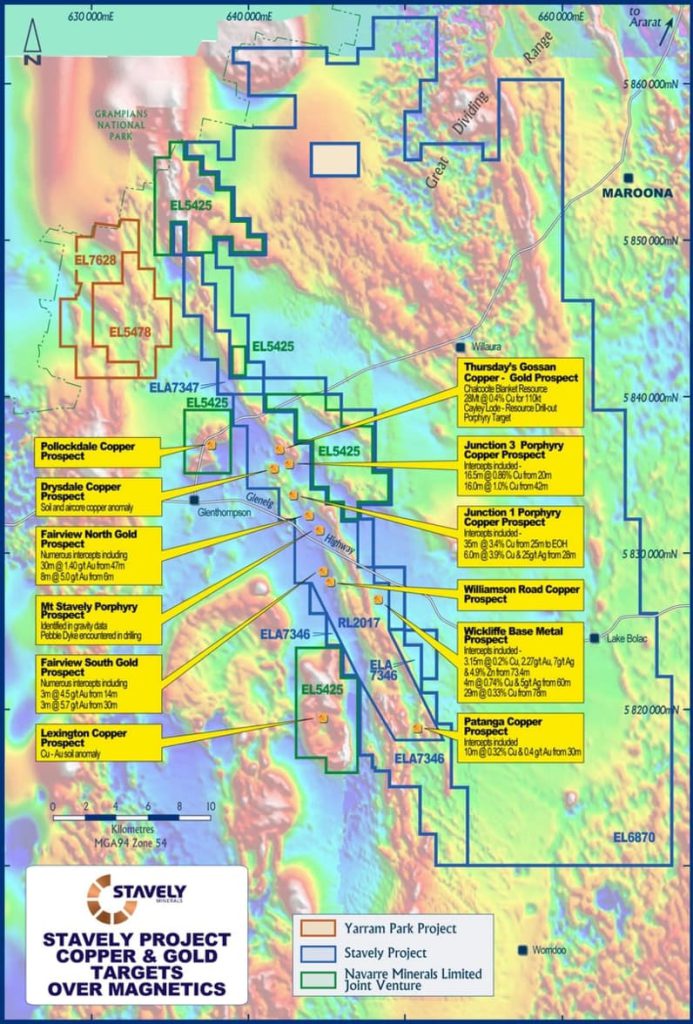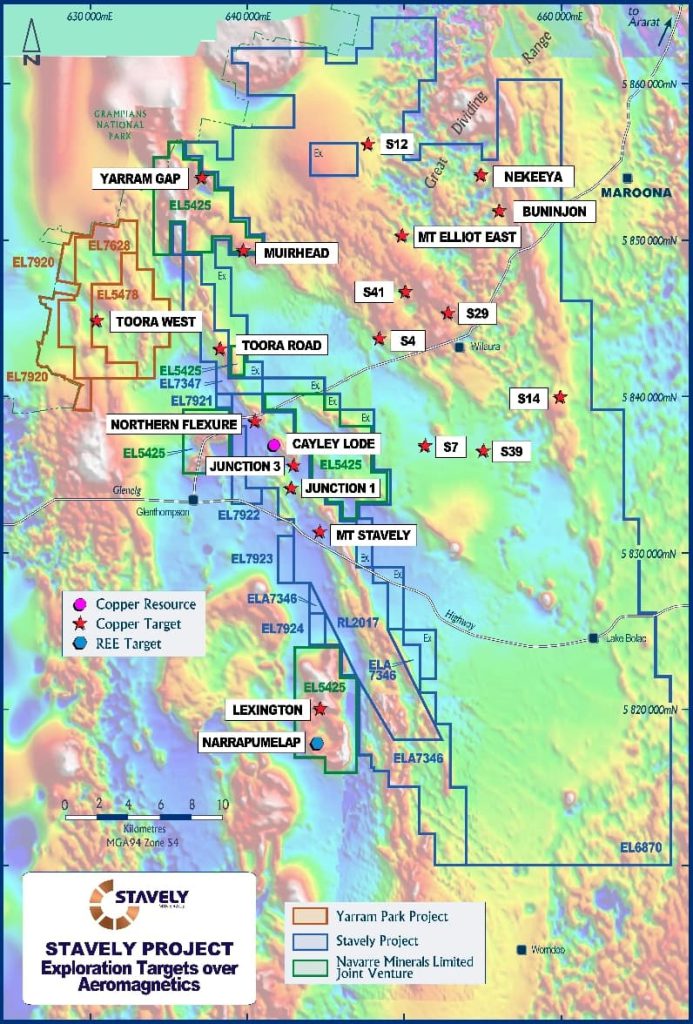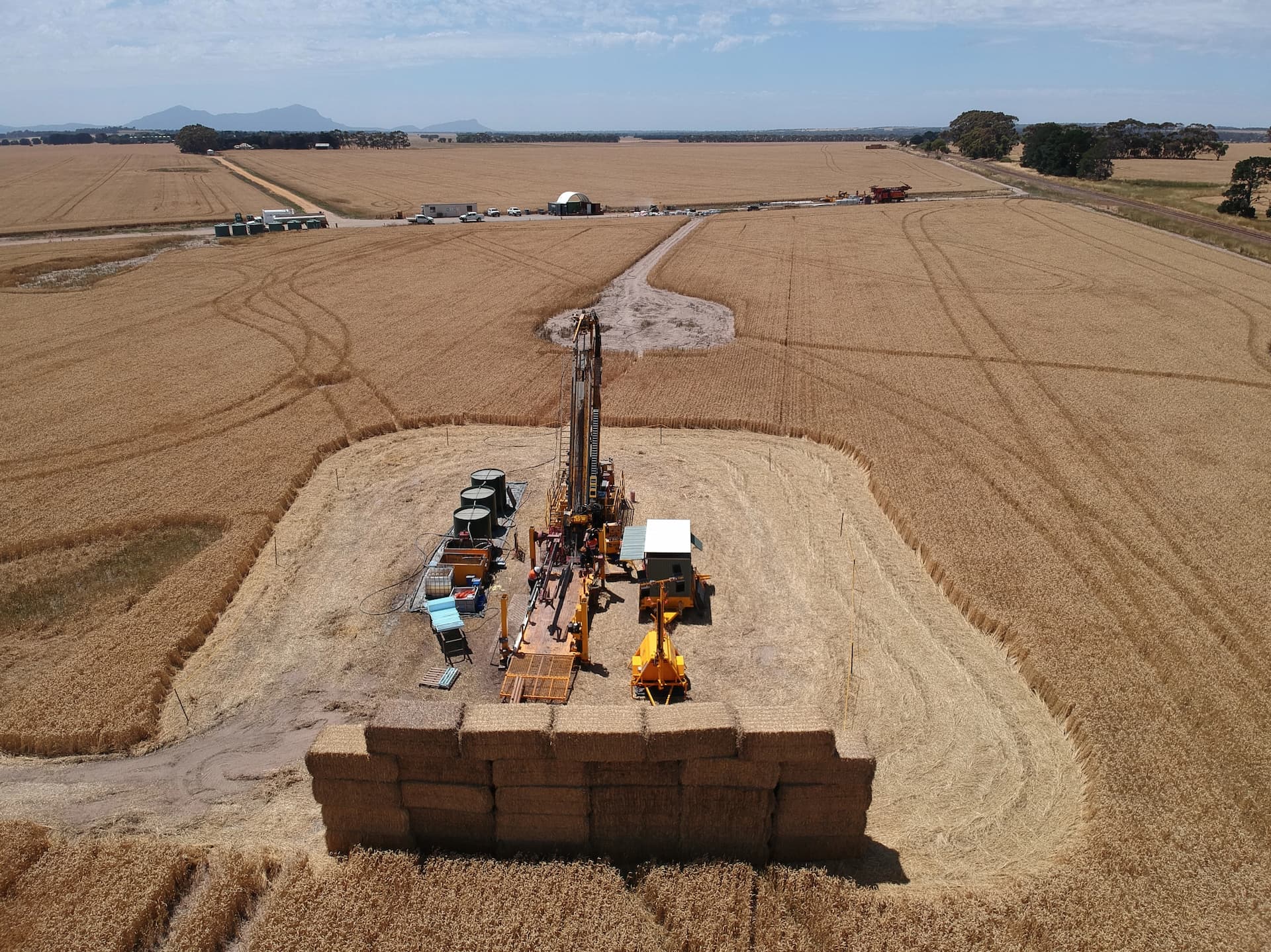
STAVELY PROJECT
>1,000KM2 | 100% OWNED
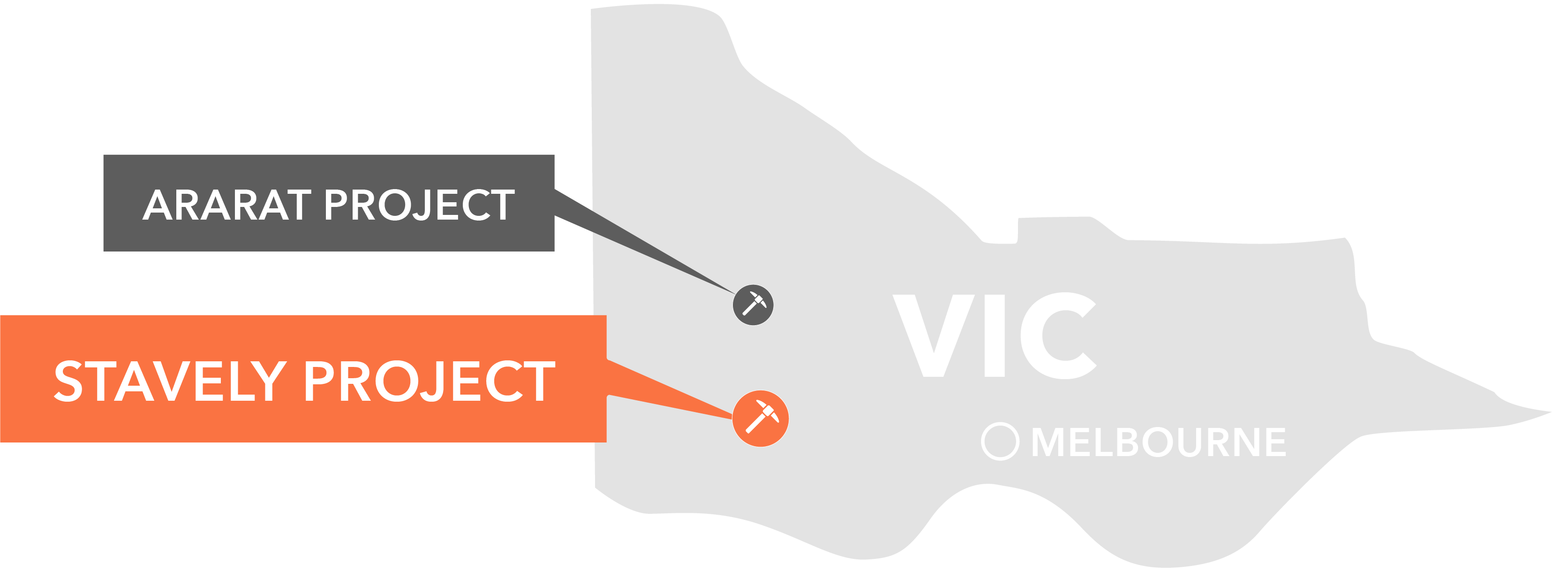
PROJECT OVERVIEW
The Stavely Project, covering an area of in excess of 1,000 square kilometres over the highly prospective Stavely Volcanic Belt in western Victoria, includes a 100% owned retention licence RL2017, 100% owned exploration licences EL6870, EL7347, EL7921, EL7922, EL7923 and EL7924 and the Black Range Joint Venture licence EL5425.
STAVELY PROJECT
The Stavely Project, covering an area of in excess of 1,000 square kilometres over the highly prospective Stavely Volcanic Belt in western Victoria, includes a 100% owned retention licence RL2017, 100% owned exploration licences EL6870, EL7347, EL7921, EL7922, EL7923 and EL7924 and the Black Range Joint Venture licence EL5425.
The Black Range Joint Venture is an earn-in and joint venture agreement with Navarre Minerals Limited. Stavely Minerals earned 80% equity in EL5425 in December 2021.
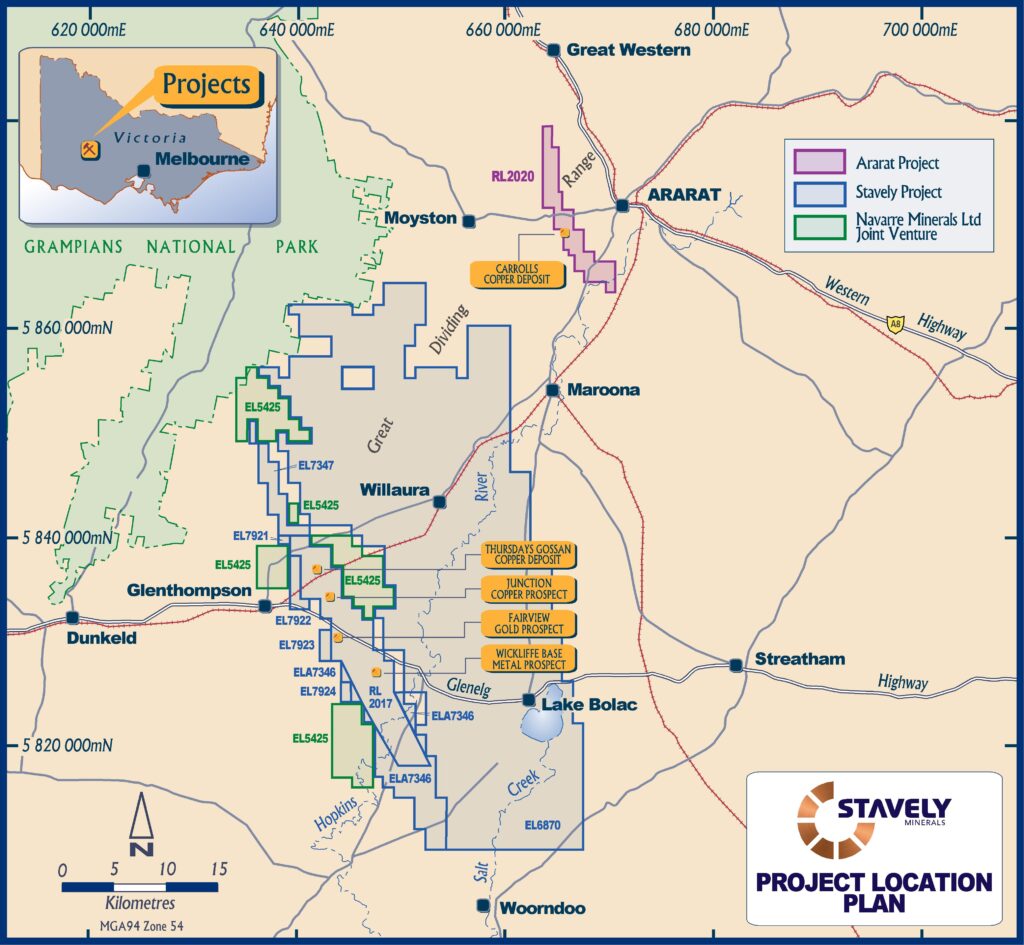
REGIONAL GEOLOGY
The Stavely Project is hosted in Cambrian age fault-bounded belts of submarine calc-alkaline volcanics, namely the Mount Stavely Volcanics, structurally in contact with the older quartz-rich turbidite sequence of the Glenthompson Sandstone and the Williamson Road Serpentinite.
These sequences were deformed in the Late Cambrian Delamerian Orogeny. Seismic traverses in western Victoria have supported the interpretation of an Andean-style continental convergent margin environment for the development of the buried Stavely Arc beneath the Stavely Volcanic Complex and environs. This regional architecture is considered conducive to the formation of fertile copper / gold mineralised porphyry systems as is the case with the younger Macquarie Arc in New South Wales, which hosts the Cadia Valley and North Parkes copper-gold mineralised porphyry complexes.
The Lachlan Fold Belt and Delamerian sequences are in fault contact through large-scale thrusting along the east dipping Moyston Fault.
Unconformably overlying both these domains by low-angle décollement is a structural outlier of the younger Silurian fluvial to shallow marine sandstone to mudstone sequences of the Grampians Group.

THURSDAY’S GOSSAN PROSPECT
In the Stavely Project, the Thursday’s Gossan prospect, which includes the Cayley Lode and the chalcocite-enriched blanket, hosts a Total Mineral Resource Estimate (using a 0.2% Cu grade lower cut-off) of – 27.3Mt at 0.69% copper, 0.10g/t gold and 3.4 g/t silver for 416Mlbs of contained copper, 86,000 ounces of gold and 3Mt of silver. Click here for details of the June 2022 Mineral Resource Estimate.
In September 2019, Stavely Minerals discovered shallow, high-grade, structurally controlled copper-gold-silver mineralisation at the Thursday’s Gossan prospect on RL2017. The first diamond hole, SMD050, drilled targeting mineralisation on the Ultramafic Contact Fault returned stunning grades of up to 40% copper within a 32m wide high-grade zone.
Initial Mineral Resource Estimate (MRE) for the Cayley Lode deposit (open pit constrained) of:
9.3Mt at 1.2% Cu, 0.2g/t Au and 7.1g/t Ag – Indicated Resources 5.87Mt at 1.04% Cu, 0.23g/t Au and 7.0g/t Ag – Inferred Resources 3.4Mt at 1.6% Cu, 0.2g/t Au and 8g/t Ag
Updated MRE completed for the Chalcocite-enriched blanket (open pit constrained) of:
18.0Mt at 0.4% Cu, 0.04g/t Au and 1.6g/t Ag, – Indicated Resources 15.3Mt at 0.42% Cu, 0.04g/t Au and 1.6g/t Ag – Inferred Resources 2.7Mt at 0.4% Cu, 0.02g/t Au and 1g/t Ag
Recent drill intercepts at depth on the Cayley Lode to the south-east indicate that there remains significant scope to define high-grade mineralisation by extending the initial Mineral Resource estimate as indicated by recent drill holes SMD182 and SMD173 (both holes were included in the underground MRE):
SMD182:
10.40m at 4.34% Cu, 3.17g/t Au and 11g/t Ag from 421.1m down-hole, incl. – 4.90m at 6.74% Cu, 6.45g/t Au and 19g/t Ag from 426m, incl. – 0.9m at 7.17% Cu, 30.6g/t Au and 52g/t Ag from 430m
SMD173:
43m at 2.60% Cu, 0.42g/t Au and 10g/t Ag from 378m down-hole, incl. – 3m at 10.38% Cu, 3.00g/t Au and 71g/t Ag, from 396m, incl. – 1m at 19.65% Cu, 8.29g/t Au and 202g/t Ag from 397m.
At Thursday’s Gossan there are at least two additional structures that host high-grade copper-gold-silver mineralisation, namely the Copper Lode Splay and the North-South Structure Lode.
Only very limited drilling has been conducted to test these targets, however intercepts including 6m at 6.73% copper, 0.84g/t gold and 15g/t silver from 538m were returned from the Copper Lode Splay and 18m at 3.62% copper, 0.28g/t gold and 15g/t silver from 848m were returned from the North–South Structure Lode.
While drilling to-date targeting the copper-gold porphyry has returned extremely encouraging indications that the system is a very hydrous, strongly oxidised and well-endowed with metals, and has all the attributes that it is well-mineralised, the economical porphyry has yet to be discovered. The search for the mineralised porphyry is on-going, including undertaking a seismic survey, structural studies and deep diamond drilling.
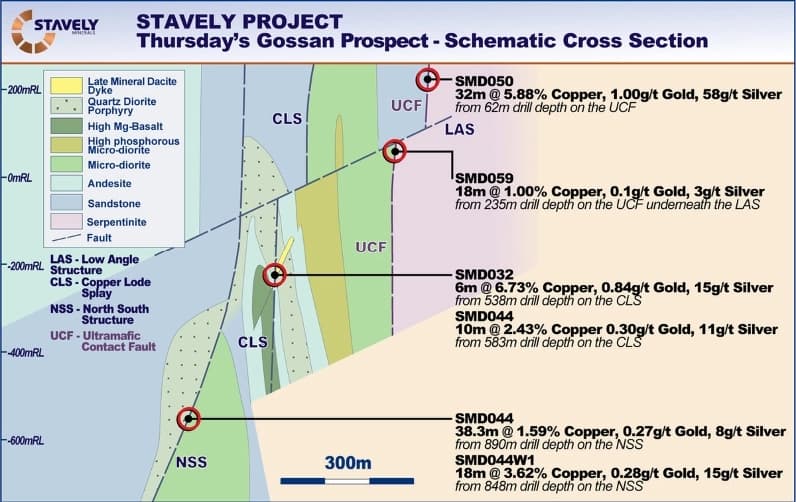
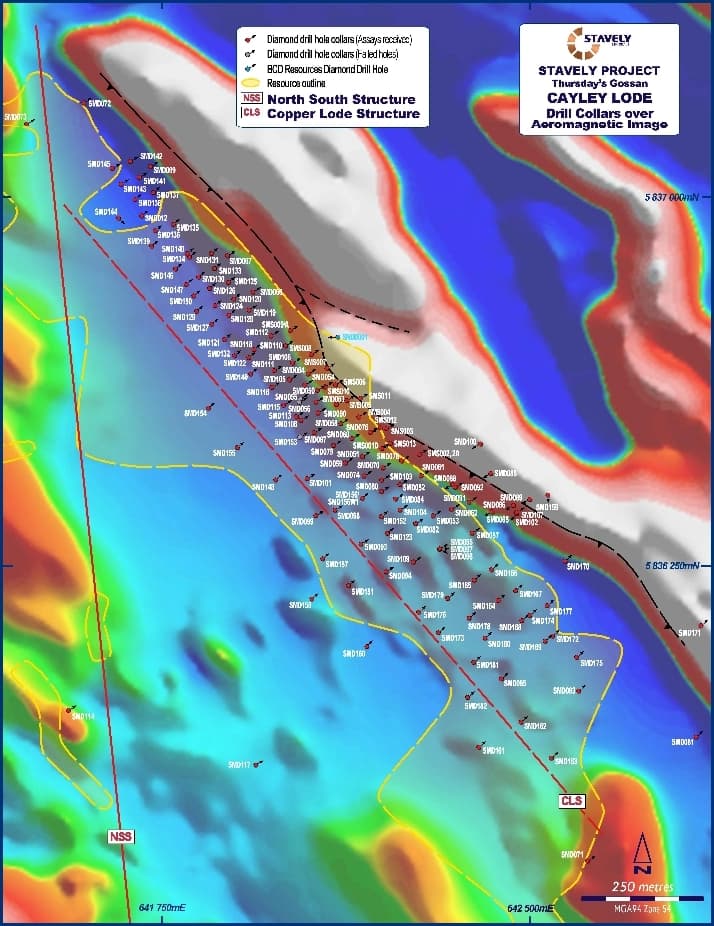
REGIONAL PROSPECTS
The known prospects that are largely exposed or located in areas of sub-crop that have been previously identified by either reconnaissance mapping or stream/soil geochemical sampling programs (Figure below with copper and gold prospects over magnetics).
Soil auger sampling was completed in areas of sub-crop including Thursday’s Gossan, Mount Stavely, Mount Stavely East, Fairview, Highway, Northern Flexure, Pollockdale, Lexington and the Southern Intrusion prospects.
In addition to the known historical prospects, the Stavely Minerals’ geology team has identified a large number of additional priority targets under shallow cover. A large number of these ‘blind’ prospects have never been previously tested. The priority target locations are shown in the figure with aircore targets over aeromagnetics.
Due to the lack of geological data owing to pervasive “Newer Volcanic” basalt cover, targeting is reliant on the interpretation based on aeromagnetics and gravity. Aircore drilling was completed at the Yarram Gap, Muirhead, S4, S41, S29, Mt Elliot East, Nekeeya and Buninjon Prospects and the program was designed as wide-spaced first-pass drilling. The aircore drilling identified porphyry/ intrusive phases associated with argillic/phyllic alteration, quartz veining and sulphide mineralisation.
